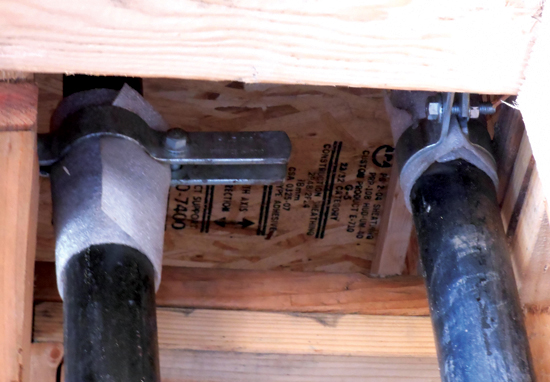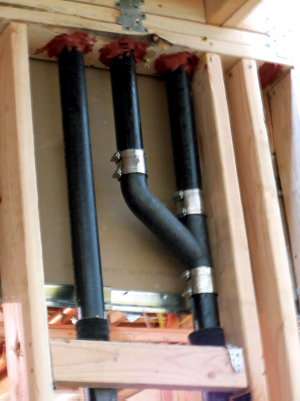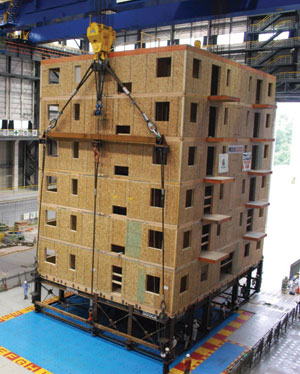Multi-Story Wood Construction
Differential Movement

Photo: WoodWorks
Plumbing sleeve connected to structure with foam wrap to allow vertical movement of structure.

Photo: WoodWorks
Plumbing joints with pipes nested in joint to allow for vertical movement of structure.
Allowing for differential movement between wood and other structural elements and building finishes is critical. Steel, concrete and brick continue to expand and contract due to temperature changes, while wood generally maintains its dimensions having reached its EMC. Differential movement occurs when, for example, floor joists are supported by a wood-frame wall at one end and by the masonry block of an elevator shaft at the other end. Areas such as stairwells, shafts and vaulted ceilings require attention for differential movements as do plumbing, electrical and mechanical systems. Using flexible joints such as flexible pipe, conduit, couplings, elbows, and tees for electrical, mechanical and plumbing between floors can prevent potential problems. The design of the joints between building envelope components, such as windows and doors, must also allow for differential shrinkage.
Seismic Requirements
Earthquakes and rigorous seismic requirements are a well-known aspect of building on the west coast, but other parts of the country, especially in the east, are not immune to earthquake activity and the need to comply with seismic codes. Wood structures offer a high strength-to-weight ratio over those built with steel and concrete (concrete walls are about seven times heavier than typical wood-frame walls) resulting in a low inertia force during earthquakes. In wood-frame buildings, the large number of walls and floors often used in a project transfer lateral loads induced by winds and seismic forces.

Photo: John Van De Lindt, Univ. Of Alabama
After being lifted to a shake table and subjected to four progressively intense earthquakes, this six-story light-frame building was found to have only minimal damage to the gypsum wallboard and nail connections. (View a video of the test on YouTube.7)
Wood-frame construction also provides numerous load paths through shear walls and diaphragms, which typically have hundreds of structural elements and thousands of nail connections, adding ductility and redundancy to the system. Redundant load paths give additional assurance that loads will be transferred should a connection fail. In contrast, structures supported by heavy non-wood frames have relatively few structural members and connections, meaning fewer load paths. Moreover, the large number of walls reduces the loads shared by each wall. Tests and observations from past earthquakes show that wood buildings have performed well. For example, a six-story light-frame wood building tested on the world's largest shake table in Japan resisted a major 2,500-year earthquake with minimal damage.
Current building code requirements for wood diaphragms, shear walls and holdown devices work effectively in creating earthquake-resistive structures. Horizontal diaphragms in roofs and floors transfer the horizontal forces to the shear walls. Shear walls with holdowns such as a continuous tie-down rod system resist the tension forces in an overturning scenario, while wood studs or columns absorb the compression forces.
In high seismic areas, mid-ply shear walls (i.e., walls with sheathing sandwiched between 2x studs oriented flatwize) have twice the load capacity as traditional shear walls and can be used where increased lateral load capacity is required. This solution would be useful in lower floor lobby areas in multi-story buildings or for stacked corridors and isolated exterior walls.










